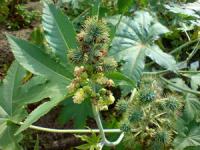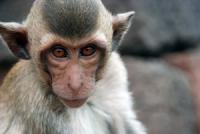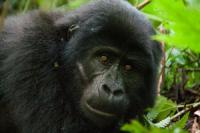-
New material helps fight against hospital-acquired infections
Researchers have developed a new light-activated antimicrobial material for use in the fight against the most common hospital infections. Specifically, the new material is a molybdenum complex that has never been used before in antimicrobial photodynamic therapy (PDT).
-
-
U.S. harvests to suffer from climate change
Some of the most important crops risk substantial damage from rising temperatures. To better assess how climate change caused by human greenhouse gas emissions will likely impact wheat, maize and soybean, an international team of scientists now ran an unprecedentedly comprehensive set of computer simulations of U.S. crop yields. The simulations were shown to reproduce the observed strong reduction in past crop yields induced by high temperatures, thereby confirming that they capture one main mechanism for future projections.
-
-
Drug-resistant “nightmare bacteria” can diversify, spread
A family of highly drug-resistant and potentially deadly bacteria may be spreading more widely — and more stealthily — than previously thought. CRE, which tend to spread in hospitals and long-term care facilities, cause an estimated 9,300 infections and 600 deaths in the United States each year, according to the DCD.
-
-
Nevada woman killed by superbug resistant to every known antibiotic
A 70-yer old woman in Nevada has died after a superbug which infected her proved resistant to every available type of antibiotic. The woman was already infected in India, where she had an extended stay, and was hospitalized there several times. She returned to Nevada in August 2016. She was admitted to a hospital shortly after her return, but died a month later after treatment with twenty-six different antibiotics was futile.
-
-
Old antibiotics, new tools to combat bio agents
More than 100 antibiotic compounds have been discovered since Alexander Fleming invented penicillin in 1928, but none within the past thirty years. Now a joint venture is exploring a new class of tetracycline that could combat biological threats to our warfighters.
-
-
Influenza: The search for a universal vaccine
No one wants to catch the flu, and the best line of defense is the seasonal influenza vaccine. But producing an effective annual flu shot relies on accurately predicting which flu strains are most likely to infect the population in any given season. It requires the coordination of multiple health centers around the globe as the virus travels from region to region. Once epidemiologists settle on target flu strains, vaccine production shifts into high gear; it takes approximately six months to generate the more than 150 million injectible doses necessary for the American population. With current technology, there may never be a “one and done” flu shot. And epidemiological surveillance will always be necessary. However, it is not inconceivable that we can move from a once-per-year model to a once-every-10-years approach, and we may be within just a few years of being there.
-
-
Ground-breaking discovery for world food security
Researchers have made a discovery that could help conquer the greatest threat to global food security – pests and diseases in plants. The researchers say this could be a game-changer for crop protection. “In agriculture, the need for new control agents grows each year, driven by demand for greater production, the effects of climate change, community and regulatory demands, and toxicity and pesticide resistance,” one researcher said.
-
-
New framework needed for estimating the social cost of carbon: Report
To estimate the social cost of carbon dioxide for use in regulatory impact analyses, the federal government should use a new framework that would strengthen the scientific basis, provide greater transparency, and improve characterization of the uncertainties of the estimates, says a new report by the National Academies of Sciences. The report also identifies a number of near- and longer-term improvements that should be made for calculating the social cost of carbon.
-
-
St. Jude's cardiac devices vulnerable to hacking: FDA
The FDA confirmed that St. Jude Medical’s implantable cardiac devices are vulnerable to hacking. Once hackers gain access to the device, they could deplete the battery or administer incorrect pacing or shocks. The devices — pacemakers and defibrillators — are used in heart patients.
-
-
Lawmakers want to know more about Ricin mix-up

Members of the Committee on Homeland Security sent a letter on 23 December to FEMA administrator Craig Fugate, demanding answers on how many years had first responders unknowingly trained with toxic Ricin at Anniston’s Center for Domestic Preparedness (CDP). In a three-page letter, members of the committee demanded answers for twelve questions, addressing the issue of how lethal toxin was used and the agency’s response once it found out about the mix-up.
-
-
Odds are against a large Zika outbreak in the U.S.
Is the United States at risk for a large-scale outbreak of Zika or other mosquito-borne disease? While climate conditions in the United States are increasingly favorable to mosquitos, socioeconomic factors such as access to clean water and air conditioning make large-scale outbreaks unlikely, according to new analysis of existing research — but small-scale, localized outbreaks are an ongoing concern.
-
-
$1.87 million for biothreat vaccine research
CUBRC, Inc. two weeks ago announced that CUBRC’s Biological and Medical Sciences team, in collaboration with EpiVax, Inc., has received a four-year grant worth $1.87 million from the Defense Threat Reduction Agency (DTRA) within the Department of Defense (DoD). CUBRC, EpiVax, and scientists at the University of Florida will be investigating immune cells from patients that were previously infected with Burkholderia pseudomallei to understand how this bacterium evades the human immune system and use that information to engineer an effective vaccine.
-
-
Final trial results confirm Ebola vaccine provides high protection against disease

Since Ebola virus was first identified in 1976, sporadic outbreaks have been reported in Africa. But the 2013-2016 West African Ebola outbreak, which resulted in more than 11,300 deaths, highlighted the need for a vaccine. An experimental Ebola vaccine was highly protective against the deadly virus in a major trial in Guinea, according to results published in The Lancet. The vaccine is the first to prevent infection from one of the most lethal known pathogens, and the findings add weight to early trial results published last year.
-
-
The new “100% effective” Ebola vaccine owes a debt to the scientists who beat smallpox

Almost a year after the official end of the Ebola outbreak in West Africa, the final results from one of the only Ebola vaccine trials are now in – and they look very promising. Despite being carried out under some of the most challenging conditions, the trial appears to be an exceptionally well-run study, comprehensive in its nature, and with a very positive result. This surely cements this vaccine as one important tool in controlling outbreaks of Ebola in the future. It also gives us a way to test new vaccines for other viruses that can crop up and take us by surprise, such as Lassa fever virus and Nipah viruses. We just have to hope that scientists have got more vaccines in the pipeline for us to test.
-
-
Whitefly: a formidable threat to food security
Researchers have sequenced the genome of the whitefly (Bemisia tabici), an invasive insect responsible for spreading plant viruses worldwide, causing billions of dollars in crop losses each year. The genome study offers many clues to the insect’s remarkable ability to resist pesticides, transmit more than 300 plant viruses, and to feed on at least 1,000 different plant species.
-
More headlines
The long view
Ransomware Attacks: Death Threats, Endangered Patients and Millions of Dollars in Damages
A ransomware attack on Change Healthcare, a company that processes 15 billion health care transactions annually and deals with 1 in 3 patient records in the United States, is continuing to cause massive disruptions nearly three weeks later. The incident, which started on February 21, has been called the “most significant cyberattack on the U.S. health care system” by the American Hospital Association. It is just the latest example of an increasing trend.
